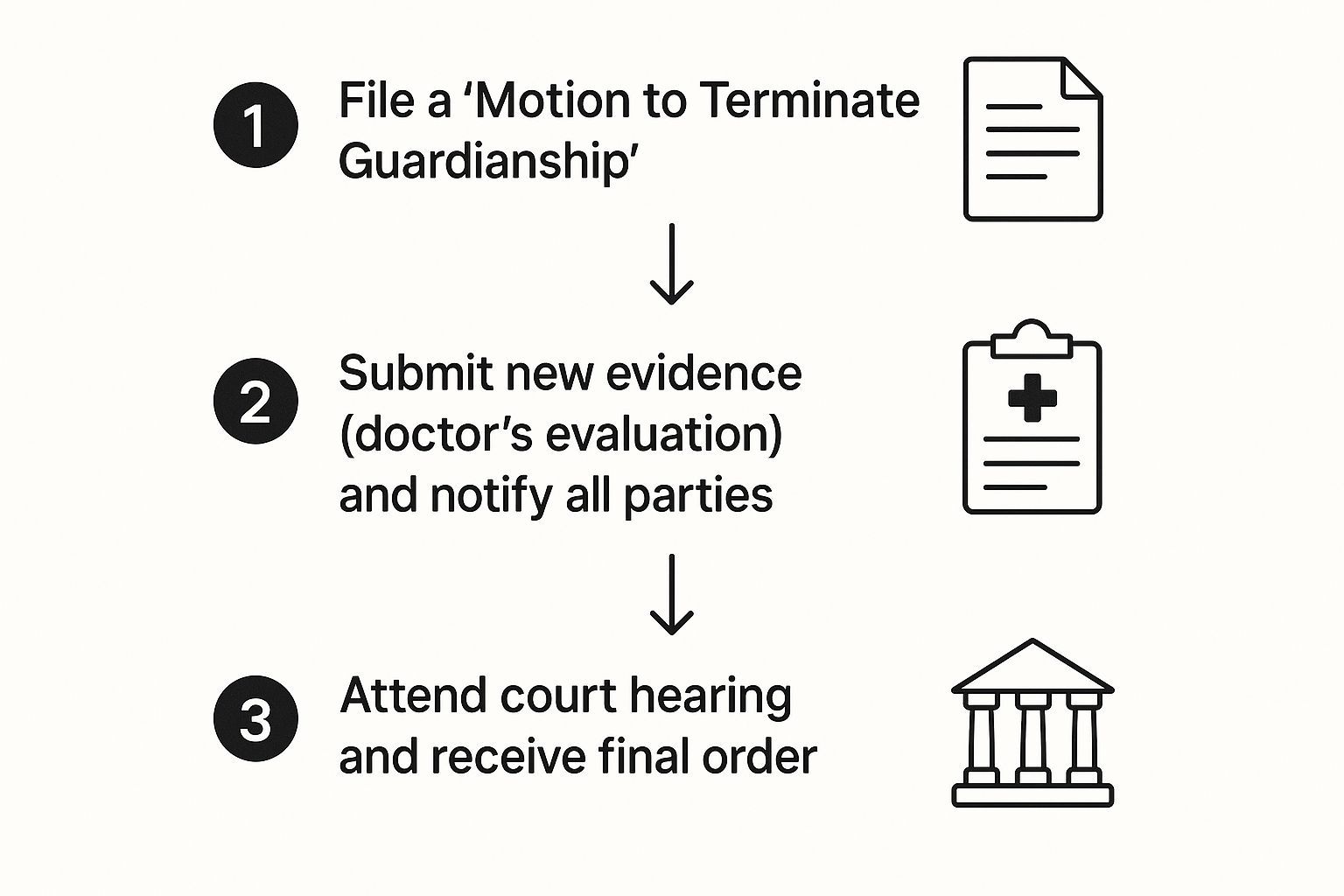Ending a guardianship in Texas is more than a simple decision; it requires a formal court process to prove that the legal protection is no longer necessary. This often occurs when the person under guardianship—known as the 'ward'—recovers the ability to manage their own affairs, or when a minor ward legally becomes an adult at age 18. This entire process is carefully outlined in the Texas Estates Code, providing families a clear, respectful path forward when circumstances improve.
We understand that this journey can be emotionally complex. At The Law Office of Bryan Fagan, our mission is to guide Texas families through guardianship law with clarity and care, ensuring your loved one's dignity and rights are always the priority.
When Can a Texas Guardianship Be Terminated?

Guardianship is a significant legal measure designed to protect a vulnerable loved one, but it is not always permanent. Texas law recognizes that life circumstances change, and a guardianship that was once essential may no longer be needed. The first step toward ending a guardianship is understanding the valid legal reasons for doing so.
The core principle is simple: a guardianship should end when the reasons for its creation no longer exist. This is not just a legal formality; it is a fundamental acknowledgment of a person's right to autonomy and self-determination.
Grounds for Termination Under Texas Law
The Texas Estates Code, specifically Title 3, Subtitle G, provides the legal framework for ending a guardianship. A court, such as a Harris County Probate Court, will consider specific situations when deciding whether to terminate the arrangement.
Here are the most common grounds for terminating a guardianship in Texas:
- Restoration of Capacity: This is the most hopeful reason. The ward has regained the physical or mental ability to care for themselves and manage their own financial affairs.
- The Minor Reaches Adulthood: When a child under guardianship turns 18, the arrangement ends by operation of law unless they have a disability that requires ongoing support.
- The Ward's Death: Upon the ward's death, the guardianship concludes, and the guardian's duties shift to closing the guardianship estate.
- Lack of Necessity: A judge may determine the guardianship is no longer essential for the ward's well-being, especially if less restrictive alternatives, like a supported decision-making agreement, have become a better fit.
The key takeaway is that the law provides a pathway to restore independence. If a loved one recovers from a serious medical event and can once again make their own decisions, the law doesn't just allow for termination—it encourages it.
Real-World Scenarios for Ending a Guardianship
Let's consider a practical example. Imagine an adult who suffered a traumatic brain injury and required a guardian to handle medical and financial decisions during their recovery. After months of dedicated rehabilitation, their doctor certifies that they have regained full decision-making capacity. In this scenario, the family can petition the court to terminate the guardianship, restoring their loved one's legal independence.
Unfortunately, tracking how often this happens is challenging due to a nationwide lack of comprehensive data on guardianship outcomes. Many U.S. courts still rely on paper-based systems, making it difficult to gather statistics on the effectiveness of these legal protections. A recent report highlights many of these challenges in guardianship data collection.
Here at The Law Office of Bryan Fagan, we have seen firsthand the emotional and legal maze families must navigate. If you believe a guardianship is no longer the right fit for your loved one, our experienced team can show you the way. Schedule a free consultation today to discuss your family’s unique situation and get the clarity you need to move forward.
Legal Pathways for Ending a Guardianship

When the time comes to end a guardianship, Texas law offers a few distinct routes. The path you take often depends on a simple question: does everyone involved agree that the guardianship is no longer needed?
Understanding your options helps demystify the legal process and empowers you to take the right steps for your family. The two primary ways to terminate a guardianship are by mutual agreement or through a contested court hearing. While each approach has its own procedures and emotional landscape, both lead to a Texas probate court for a final decision.
The Standard of Proof in Termination Cases
To successfully end a guardianship, you must prove to the court that it is no longer necessary. The legal standard for this is a "preponderance of the evidence." While this sounds technical, it simply means you must show that it is more likely than not that the ward can now manage their own affairs.
Interestingly, this is a lower burden of proof than the "clear and convincing evidence" required to establish a guardianship in the first place. This legal distinction reflects the law's strong preference for individual liberty. Once a person can demonstrate their capability, the court is inclined to restore their legal rights.
Agreed vs. Contested Terminations
In the best-case scenario, everyone is on the same page. Imagine a family in Harris County whose elderly parent has made a full recovery from a major illness. The parent, the guardian (their adult child), and other family members all agree that the parent can make decisions independently again.
When this happens, the process is generally much smoother. The parties can file an agreed motion with the court, supported by a new physician's evaluation. The hearing is often straightforward, as the judge simply needs to confirm the facts and sign the order terminating the guardianship.
A contested termination, however, is far more complex. This occurs when there is a disagreement. For instance, a ward might feel they have regained capacity, but the guardian disagrees, believing the protection is still vital. Both sides will present evidence and testimony at a formal hearing, and the court will decide if the preponderance of the evidence standard has been met.
For those trying to figure out the specific paperwork needed for these kinds of legal actions, looking at resources with useful templates for legal documents can be a good starting point.
The court’s primary goal is always to protect the ward. In a contested hearing, the judge will carefully examine all evidence—medical records, expert testimony, and personal statements—to make a decision that serves the ward’s best interests.
Pathways to Terminating Guardianship in Texas
Here’s a clear breakdown of the primary methods for ending a guardianship, who can initiate the process, and what they generally need to show the court.
| Method of Termination | Who Can Initiate | Key Requirement |
|---|---|---|
| Recovery of Ward | The ward, the guardian, or any interested person. | Proof that the ward has regained capacity to manage their own affairs. |
| Ward Reaches 18 | Automatic or initiated by the guardian. | The minor ward has legally become an adult. |
| Death of Ward | The guardian. | A certified death certificate is presented to the court. |
| Agreement | All interested parties, including the ward. | Mutual consent that the guardianship is no longer necessary or in the best interest. |
This table simplifies the main avenues, but remember that the specifics can vary based on your county and the unique facts of your case.
It is difficult to find reliable data on how often these different outcomes occur. National surveys show significant variation in how states use guardianship, which impacts termination rates. According to one study, the proportion of adults with disabilities under guardianship ranged from 5.5% in one state to a staggering 89% in another. You can explore these disparities in guardianship practices through the National Core Indicators project.
This variability highlights the importance of understanding your local court's procedures and why exploring alternatives to guardianship from the outset can sometimes be the most empowering choice for a family.
Navigating the Court Process to End Guardianship
Starting the court process to end a guardianship in Texas can feel intimidating, but it doesn't have to be. Understanding the steps involved can turn anxiety into confidence. Whether you're in Fort Bend County or Montgomery County, the judicial path is structured and designed to protect everyone involved.
The first step is filing a formal document called a Motion to Terminate Guardianship. This is filed with the same probate court that originally established the guardianship. This motion is your official request to the judge, explaining exactly why the guardianship is no longer needed. It's more than just paperwork; it’s the legal key to restoring a person's independence.
The Critical Role of New Evidence
Simply telling the court that circumstances have changed is not enough; you must prove it. The Texas Estates Code requires compelling, current evidence. The single most important piece of evidence is an updated evaluation from a physician.
A doctor’s letter or a formal report must state clearly that the ward has regained the capacity to handle their own personal and financial affairs. This medical opinion serves as the backbone of your case. It provides the judge with the professional, objective assessment needed to consider undoing a legal protection they previously deemed necessary. Without it, your motion is unlikely to succeed.
Notifying All Parties and Preparing for the Hearing
Once your motion and supporting medical evidence are filed, the next step is to legally notify all "interested parties." This is a mandatory legal requirement, not just a courtesy. These parties typically include the current guardian, the ward (if they are not the one filing), and close family members who were notified when the guardianship began. This ensures the process is transparent and gives everyone an opportunity to be heard.
After notification, the court will set a date for a hearing. This is your day in court, where you, your attorney, the guardian, and the ward will appear before the judge. During the hearing, the judge will review all the evidence, listen to testimony, and ask questions to get a complete picture. Though it is a formal proceeding, its purpose is straightforward: to determine if ending the guardianship is truly in the ward's best interest.
This infographic breaks down the core steps you'll take in a Texas court.

As you can see, terminating a guardianship is a procedural sequence. It starts with a legal filing, is built on solid evidence, and concludes with a judge's final decision.
A common challenge arises when a guardian resists the termination. They might genuinely believe the ward still needs protection, leading to a contested hearing. In these situations, having a compassionate yet firm attorney is essential. You need an advocate who can present your evidence effectively and champion the ward's restored rights. You can learn more about a guardian's duties and the removal process in our guide on how to discharge a guardian in Texas.
While navigating the court system, some people find it helpful to use various legal support services for things like document preparation, similar to those used in other family law matters. Ultimately, if the judge is convinced by the evidence, they will sign a court order. This order officially terminates the guardianship and restores all legal rights to the former ward. That final signature marks the successful end of a challenging but incredibly meaningful journey.
How to Terminate Guardianship for a Minor

Ending a guardianship for a child involves a unique blend of legal and emotional considerations. This process is not just about restoring legal rights; it is often about reuniting a family. A Texas probate court will evaluate every decision through one critical lens: the best interest of the child.
This principle is paramount. It means the judge’s top priority will always be the child’s physical safety, emotional well-being, and overall stability. Keeping this principle in mind helps the entire process make more sense.
Common Reasons for Ending a Minor's Guardianship
Several life events can lead to the termination of a child's guardianship, each with its own legal path.
- The Child Turns 18: This is the most straightforward scenario. Once a minor reaches the age of majority, the guardianship automatically terminates by law, and no court action is needed.
- A Parent Is Ready to Resume Care: This is a common and hopeful situation. If a parent who was previously unable to care for their child has addressed their challenges and stabilized their life, they can petition the court to restore their parental rights and end the guardianship.
- The Minor is Adopted: Adoption creates a new, permanent parent-child relationship. This new legal bond replaces and legally terminates the prior guardianship.
The most emotionally charged cases are often those where a parent is ready to resume their role. These situations require a careful balance—celebrating a parent’s hard-won recovery while ensuring the child's world remains safe and stable.
The Court's Evaluation Process
Let's walk through a common scenario. Imagine a grandparent in Harris County was appointed guardian for their grandchild because the child's parent entered a long-term rehabilitation program. Two years later, the parent has successfully completed the program, secured stable employment and housing, and has been consistently involved in their child's life.
In this case, the parent can file a motion to terminate the guardianship. The court will then carefully evaluate several factors:
- The parent's current living situation and financial stability.
- Evidence of the parent's recovery and continued commitment to a healthy lifestyle.
- The emotional and developmental needs of the child.
- The existing relationship between the child, the parent, and the grandparent guardian.
The grandparent might be fully supportive of reunification, which makes the process smoother. However, the judge still has an independent duty under the Texas Estates Code to confirm that returning the child to the parent is truly in their best interest.
It is surprisingly difficult to track how often these guardianships for minors end. We know that nationally, about 3.7 million children live with relatives or other caregivers. However, data on why and when these arrangements end is not systematically collected, creating challenges for families and policymakers. You can learn more about the data gaps affecting children in nonparental care from recent studies.
Navigating the termination of a minor's guardianship requires both legal skill and genuine compassion. If your family is facing this situation, The Law Office of Bryan Fagan is here to offer the clear, caring guidance you deserve. Schedule a free consultation with us to discuss the best path forward for your child.
After the Guardianship Ends: What Comes Next?
Receiving a court order that terminates a guardianship is a momentous achievement. It is a profound moment that restores your loved one’s independence and marks the end of a long legal journey for your family. But while the court case is over, a few crucial administrative tasks remain. This final phase ensures a smooth and responsible transition of control back to the individual.
The process isn't truly complete when the judge signs the order. The former guardian has a final duty to the court and to the person they served: to close out the guardianship in a formal, transparent manner.
The Guardian's Final Accounting
Under the Texas Estates Code, the guardian is required to file a final accounting with the court. This is a comprehensive financial report detailing all income received and expenses paid on behalf of the ward during the final reporting period.
Think of it as the last chapter in the guardianship's financial story. It creates a clear, official record of how your loved one’s assets were managed. This report must be filed, reviewed, and approved by the judge in the Harris County or Fort Bend County probate court where the case was heard. This mandatory step protects both the former ward and the guardian, officially closing the books on the guardian’s responsibilities.
Transferring Assets and Control
Once the court approves the final accounting, the real-world transition begins. The former guardian must now transfer all remaining assets and property back to the individual. This involves several important steps:
- Changing Bank Account Ownership: Removing the guardian’s name from all bank accounts and restoring sole control to the individual.
- Retitling Property: Updating deeds for real estate, titles for vehicles, and any other significant assets to reflect the individual's ownership.
- Updating Beneficiary Information: Ensuring that all financial accounts, retirement plans, and life insurance policies reflect the individual's current wishes.
- Handing Over Important Documents: Returning all original documents, such as a birth certificate, Social Security card, and property deeds, to the individual.
This transfer of control is a tangible symbol of restored autonomy and a critical step in moving forward.
It’s a moment of empowerment, but it can also feel overwhelming. After relying on a guardian, stepping back into full control requires adjustment and support. This is the perfect time to plan for the future.
Planning for Continued Independence
The end of a guardianship does not mean the end of all support. Instead, it offers an opportunity to implement less restrictive tools that honor a person's independence while still providing a safety net. This is where proactive Estate Planning becomes invaluable.
Consider discussing options like a Durable Power of Attorney for financial matters or a Medical Power of Attorney for healthcare decisions. These documents allow the individual to choose who they trust to assist them if they ever need it, without giving up their fundamental rights. You can explore more about this crucial next phase in our guide on how to transition from guardianship to independence in Texas.
Framing this next step as a positive, forward-looking strategy ensures continued security and peace of mind for everyone. If you need help navigating this transition or setting up these vital legal tools, The Law Office of Bryan Fagan offers personalized guidance. Schedule a free consultation to discuss how we can support your family's future.
Common Questions About Ending a Guardianship
When you are considering how to terminate a guardianship, it is natural to have many questions. The process can feel complex, but getting clear, straightforward answers can provide confidence as you consider the next steps. We have compiled some of the most common concerns we hear from Texas families to help you on your journey.
How Long Does It Take to Terminate a Guardianship in Texas?
The timeline for ending a guardianship in Texas varies depending on the specific circumstances of your case.
If everyone involved—the person under guardianship (the "ward"), the guardian, and close family—is in agreement, the process can move relatively quickly. In these uncontested cases, termination might be achieved in just a few months.
However, if the termination is contested, the timeline can extend significantly. A contested case requires more court hearings, discovery of evidence, and potentially expert witnesses. This can easily stretch the process to several months or longer, depending on the probate court's docket in Harris County or Fort Bend County.
Can a Ward Start the Process to End Their Own Guardianship?
Absolutely. The Texas Estates Code explicitly protects a ward’s right to advocate for themselves. A person under a guardianship can file a motion with the court to terminate the arrangement if they believe it is no longer necessary.
To be successful, the ward must present compelling evidence that they have regained their capacity. This almost always requires a new, detailed evaluation from a physician stating that the ward is capable of managing their own personal and financial affairs. This medical evidence is the cornerstone of their case.
A ward's right to petition the court is a fundamental protection. It is a safeguard to ensure a guardianship does not last a day longer than it's truly needed, giving the person at the center of the case a powerful voice.
What Happens If the Judge Denies the Motion to Terminate?
If a judge denies the motion to terminate, the existing guardianship remains in place. The court will explain its reasoning, which is usually based on a finding that the evidence presented did not sufficiently prove, by a preponderance of the evidence, that the guardianship was no longer required.
A denial is not necessarily the end of the road. If the ward's circumstances change significantly in the future—for example, if their condition improves further—you may be able to file another motion with new, more compelling evidence of their restored capacity.
Do I Need a Lawyer to Terminate a Guardianship?
While you are not legally required to hire an attorney, navigating this process alone can be incredibly difficult. The legal paperwork is complex, the rules of evidence are strict, and courtroom procedures can be confusing for those without legal experience.
Hiring a skilled guardianship attorney is highly recommended, especially if the case is contested. A lawyer ensures all legal requirements are met, knows how to present evidence effectively, and can advocate for your loved one’s best interests. Ultimately, having an expert in your corner dramatically increases the chances of a successful outcome.
The journey to end a guardianship involves both legal and emotional challenges. At The Law Office of Bryan Fagan, PLLC, our compassionate attorneys are here to guide Texas families through every step with clarity and support. For personalized legal advice on your specific situation, schedule a free, no-obligation consultation with our team today.







